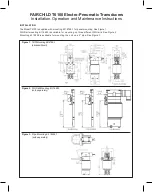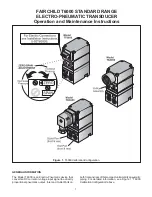
14
– Special instructions for use in explosive environments and
fonctional safety
104
be held responsible for any damage to the equipment or for any physical injury
or death resulting from any product modification.
The threaded joints on the
OLCT 80
may be lubricated to ensure protection
against explosions. Only non-hardening lubricants or non-corrosive agents
without volatile solvents may be used. Warning: silicone-based lubricants are
strictly prohibited since they contaminate some of the gas sensing elements
used in the
OLCT 80
.
Limitations of use
Gas detection cells have certain limitations that shall be known and understood
by the user.
Overange and exposition to specific components
■
A bump test and/or a calibration is recommended each time the detector has
been exposed to high gas concentration and moreover if the detector went
to overange condition.
■
Vapors from silicone or sulfur compounds can affect the catalytic sensor and
thereby distort the measurements. If the sensors have been exposed to
these types of compounds, an inspection or calibration must be performed.
■
High concentration of organic solvents (e.g. alcohols, aromatic solvents,
etc.) or exposure to gas concentration above the measuring range can
damage electrochemical sensors. If sensors have been exposed to such
condition, a bump test or calibration must be then performed.
■
In the event of high levels of Carbon Dioxide (CO2 > 1% vol.),
electrochemical Oxygen (O2) sensors can slightly overestimate the actual
concentration of oxygen by 0.1 to 0.5% volume.
Operation under low oxygen levels
■
If an electrochemical detector sensor is used in an atmosphere comprising
less than 1% oxygen for over one hour, the measurement may be an
underestimate.
■
If a thermocatalytic detector sensor is used in an atmosphere comprising
less than 10% oxygen, the measurement may be an underestimate.
■
If a semiconductor detector sensor is used in an atmosphere comprising less
than 18% oxygen, the measurement may be an underestimate.
Installation and calibration
■
The detector will be installed with the sensor cell pointing downwards
■
The detector should be calibrated with the gas to be measured. With respect
to combustible gases only, and in the event it is impossible to calibrate with
the targeted gas, see tables on pages 80 and further for recommended
calibration gas and cross gas interference.
Summary of Contents for olct 80
Page 1: ...1 User manual OLCT 80 Part Number NPO80GB Revision E 1 The Fixed Gas Detection Experts...
Page 6: ...Table of Contents vi...
Page 10: ...1 Overwiew 4...
Page 18: ...2 Transmitter Overview 12...
Page 22: ...3 Menus 16 Figure 15 the OLCT 80 s sub menus under AFF MES DATE TIME and PROG...
Page 23: ...3 Menus 17 Figure 16 the OLCT 80 s sub menus under MAINT CALIBRA 4 20mA INFOS and TEST...
Page 42: ...3 Menus 36 Figure 26 RELAY 1 menu Press ESC repeatedly to return to the reading display...
Page 58: ...3 Menus 52...
Page 74: ...5 Wireless Version 68...
Page 82: ...7 Pre installation Hardware Configuration 76...
Page 84: ...8 Preventative Maintenance 78...
Page 90: ...10 Accessories 84...
Page 96: ...12 EU Declarations of Conformity 90 OLCT 80 without antenna...
Page 97: ...12 EU Declarations of Conformity 91...
Page 98: ...12 EU Declarations of Conformity 92 OLCT 80 with antenna...
Page 99: ...12 EU Declarations of Conformity 93...
Page 100: ...12 EU Declarations of Conformity 94 IR20 remote control of the OLCT 80...
Page 108: ...13 Technical Specifications 102...
Page 116: ...14 Special instructions for use in explosive environments and fonctional safety 110...
Page 119: ...113...











































